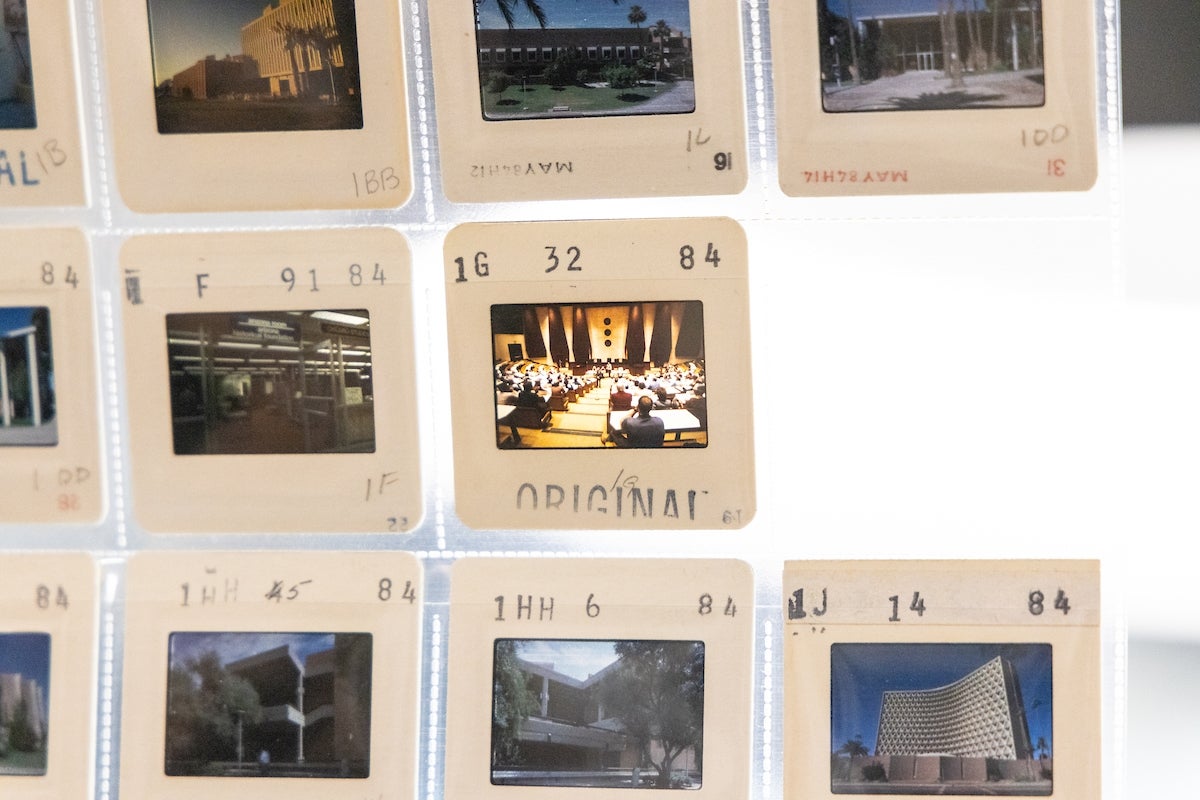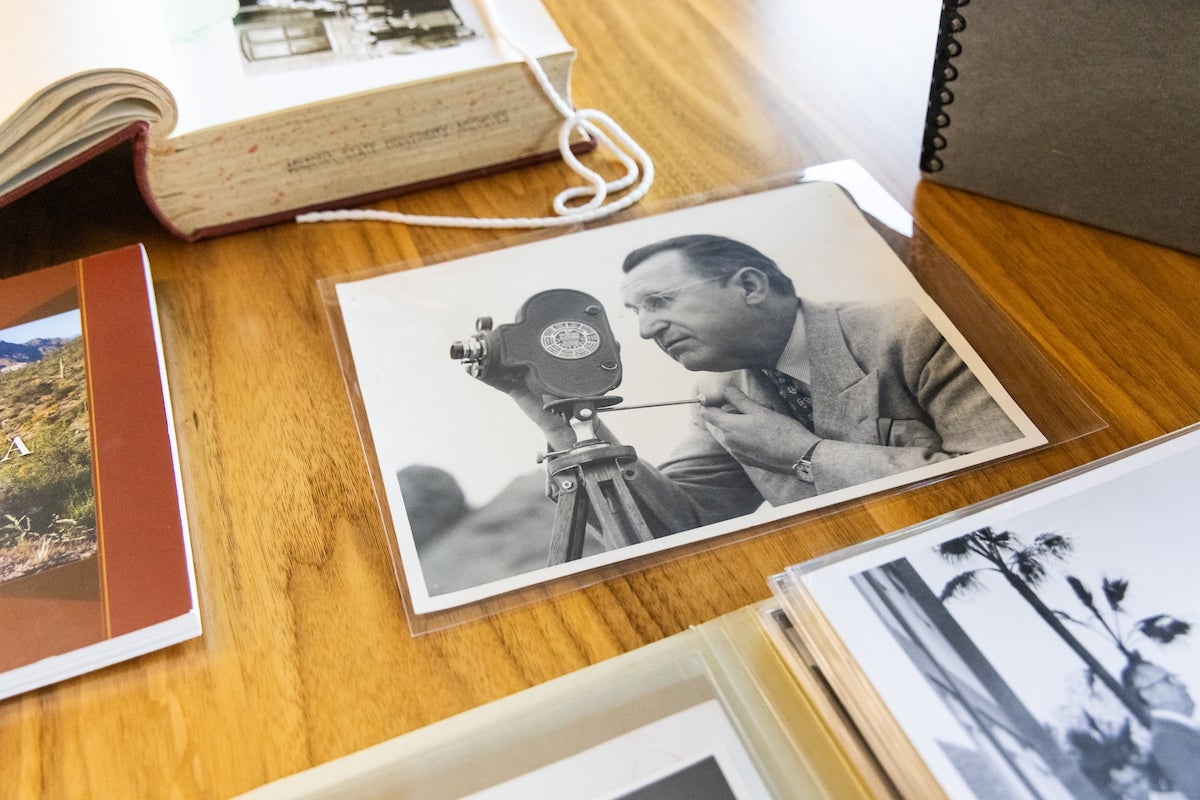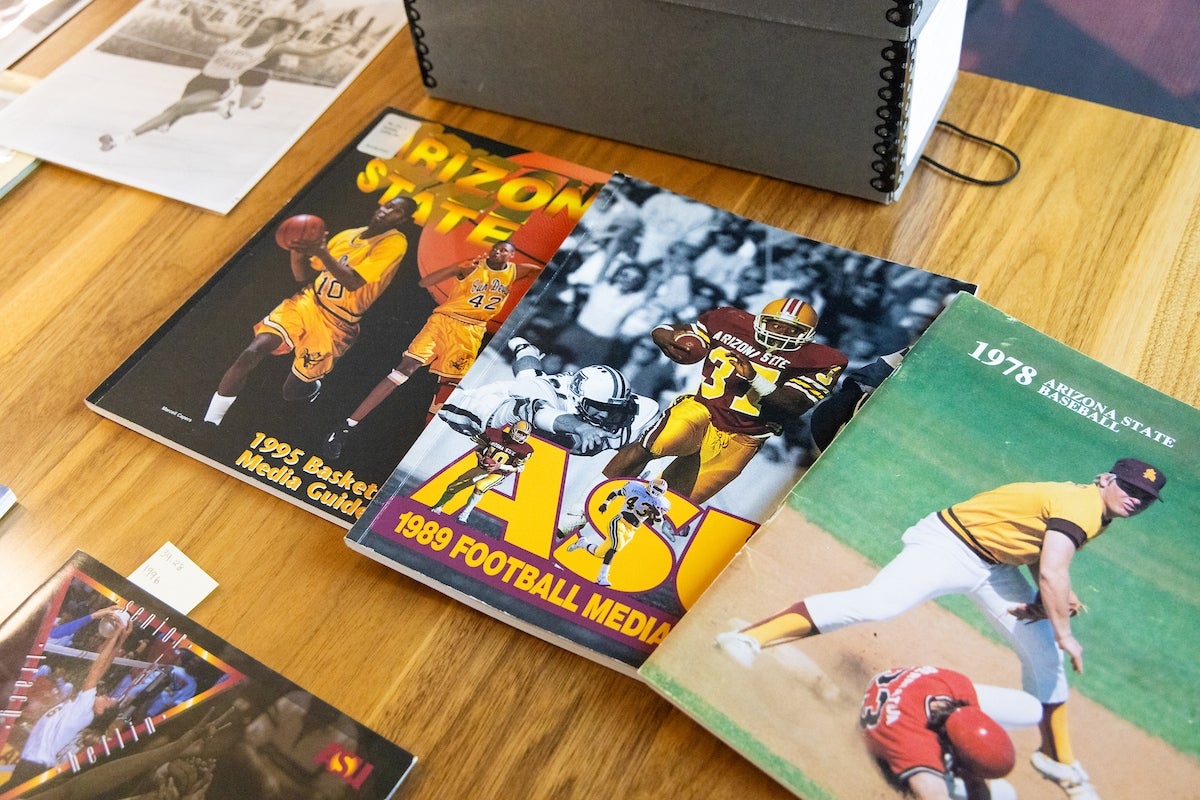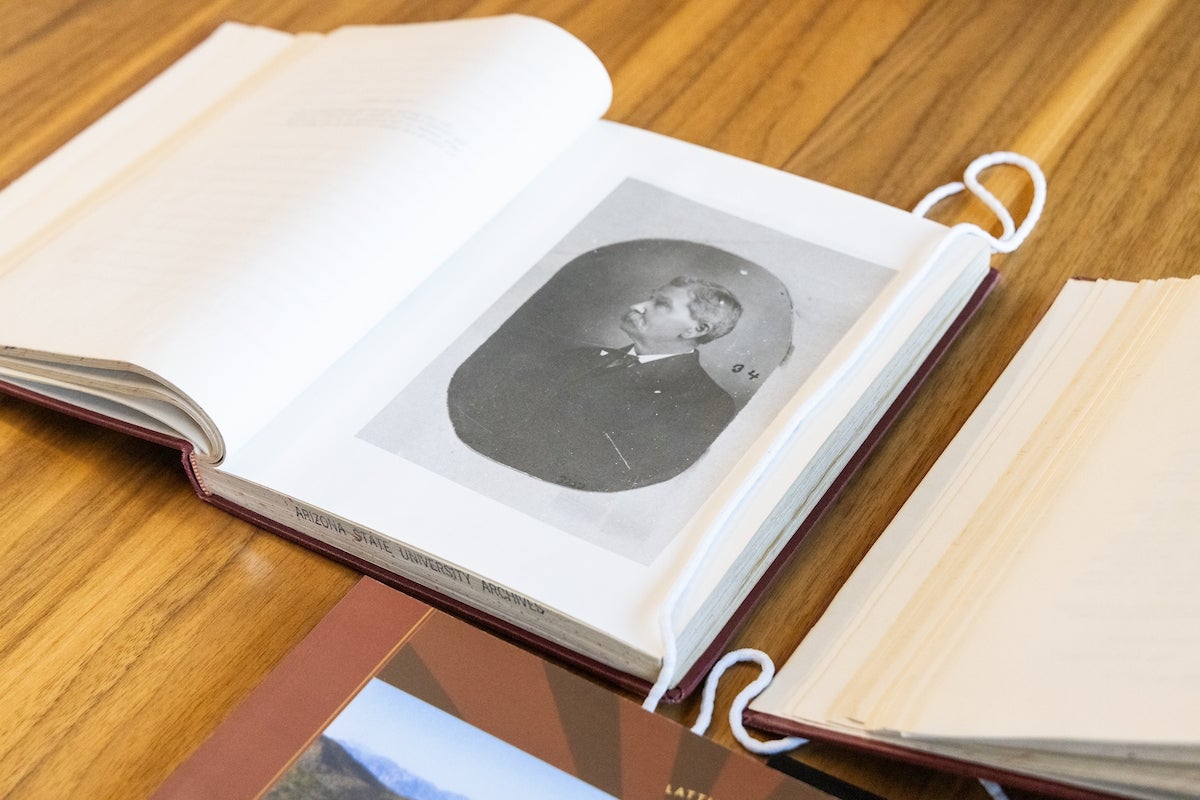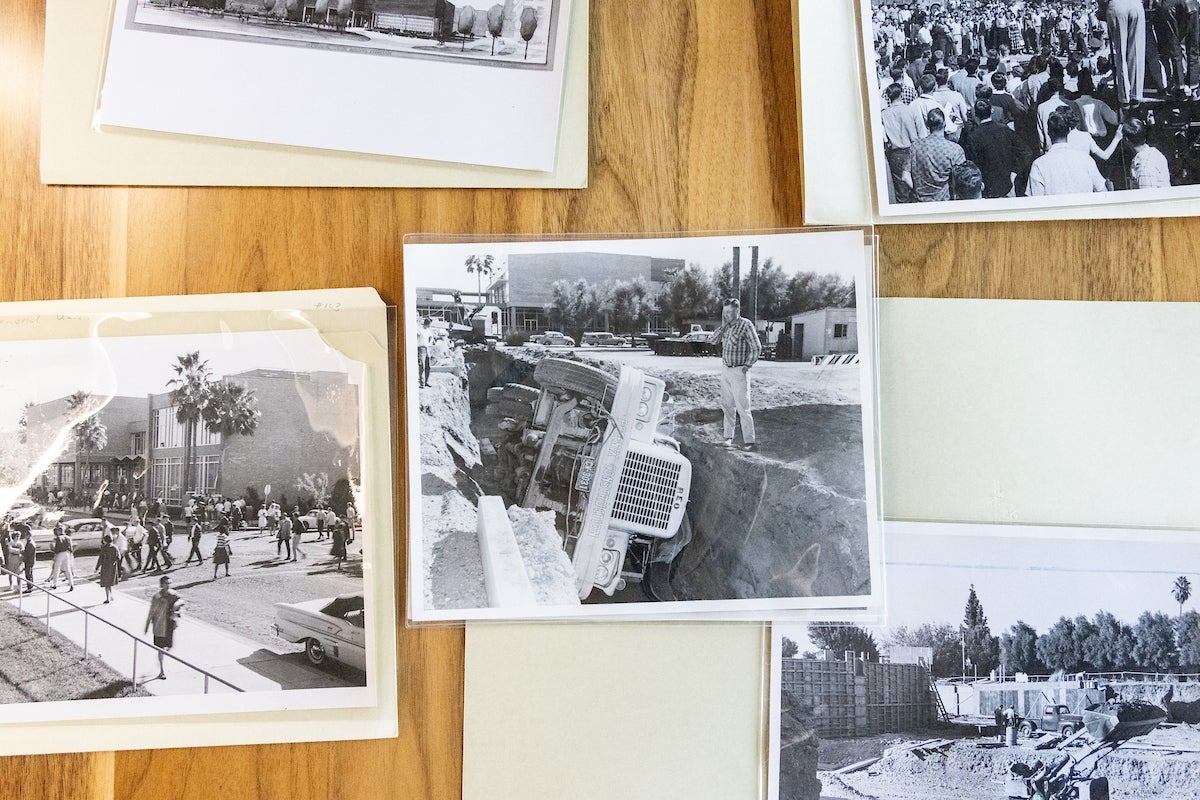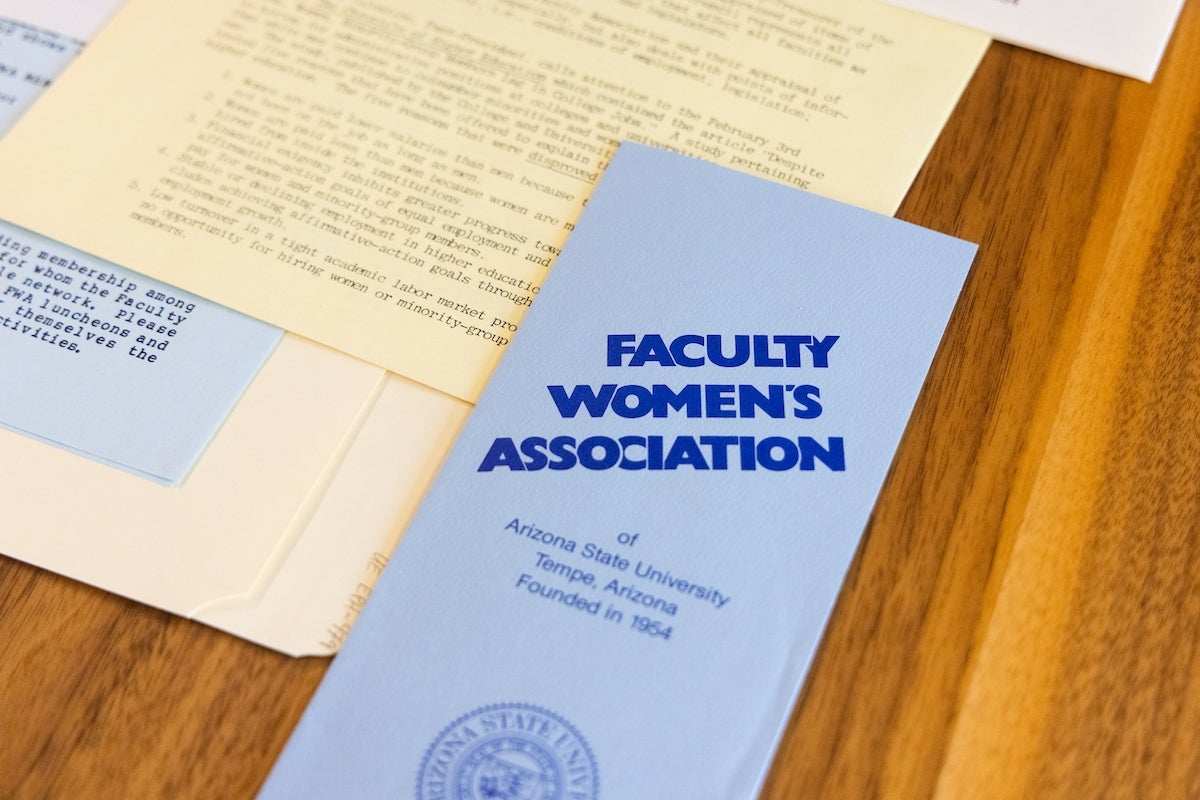University Archives chronicles more than 140 years of Sun Devil history

Shannon Walker (left), University Archives associate archivist, and Jonathan Wilcox, collections care and processing project manager, observe photos from the University Archives in the Wurzberger Reading Room at Hayden Library on the Tempe campus on Nov. 1. Photo by Emma Fitzgerald/Arizona State University
Editor’s note: This is part of a monthly series spotlighting ASU Library’s special collections throughout 2024.
What was the name of the butcher who bequeathed the first piece of land that ultimately became the nation’s largest public research university?
Who was the mastermind behind Palm Walk’s signature design, and what was the inspiration?
Why did the Territorial Cup go missing for almost a century, and how did it end up in a random Tempe basement?
The answers to these questions can be found in the university’s largest repository of all things Sun Devils.
From photos to video and audio recordings, administrative records, manuscripts, yearbooks, club information, and faculty and staff bios, the Arizona State University Archives chronicle approximately 140 years of school history — and at 7,200 linear feet, cover roughly the length of 24 Frank Kush Fields.
They also serve all four of ASU's campuses through material access, collaborations and outreach.
“ASU’s University Archives encompasses the history of the school from the beginning, all the way back to the 1880s until now,” said Shannon Walker, university archivist with the Community-Driven Archives Initiative who currently manages both the University Archives and the archival collections at Thunderbird School of Global Management. “University Archives is vast, deep and immense. It’s also very rich and unique.
"This repository reflects the lasting impact that generations of innovative ASU students, faculty and leaders have made to shape our university, our communities and the world.”
University Archives was established by the University Libraries in 1972 with the appointment of Alfred Thomas as ASU’s first university archivist. In 1973, the archives' collections were moved to the President's Cottage, the home of past presidents Arthur John Matthews, Ralph Swetman and Grady Gammage, between 1907–1959. In 1985, the University Archives became part of the Department of Archives and Special Collections. Archives collections and reference services were moved to the Luhrs Reading Room of Hayden Library in 1995.
In observance of this week's Homecoming festivities, ASU News offers a glimpse of the wide variety of materials in a collection that showcases the university's rise from a small teaching school to a knowledge enterprise that serves more than 181,000 students worldwide.
KAET Recordings/Videos
Nestled unassumingly inside the Walter Cronkite School of Journalism and Mass Communication on ASU’s Downtown Phoenix campus is one of the nation’s leading public media organizations.
With four broadcast channels and a growing array of digital platforms, Arizona PBS has been a trusted community resource for nearly 60 years.
Perhaps even more impressive is the fact their signal now reaches 80% of homes in Arizona, delivering news, science, arts and children’s programming to 1.8 million households each week.
It’s certainly come a long way from its roots when it was known as Channel 8, KAET-TV. The station first signed on the air on Jan. 30, 1961, as the nation’s 56th public television station. Initially, it broadcast from ASU’s Engineering Center from 4 to 9 p.m., Monday to Friday, offering up local programming and national fare such as “Sesame Street.”
This collection houses recordings of KAET-TV's local programs on 1-inch Betacam, VHS and U-Matic tapes. Jonathan Wilcox, a project manager in collections care and processing, has been placed in charge of digitizing and preserving these old formats.
He says the task, while daunting at times, is a tasty one.
“What I love about this process is that I love not knowing what I’m working on until I get it,” said Wilcox, who graduated with a degree in art history. “I’m kind of the chef in the kitchen. Archivists and curators are going to send me the things I need to cook up. Then I cook it up with the recipe ideal for the material type and send it back with those files exactly the way they want them.”
The California native said he’s learned a good deal of history by watching nearly 400 KAET broadcasts over the two years he’s worked at the university. Wilcox said he watched episodes of Martin Luther King Jr.’s visit to ASU in 1964, the 1984 presidential debate between Ronald Reagan and Walter Mondale and, most intriguing of all, a news clip on Tempe’s famous Big Surf, which closed in 2019 after a half-century in business.
“Being from SoCal, I was like, ‘Wow!’ I guess you really can catch a wave in Arizona, too,” Wilcox said. “You could actually see everybody riding the wave.”
ASU Athletics
You don’t have to be a sports fan to enjoy the variety in this collection.
ASU Athletics offers everything from photographs of the evolution of Sparky the mascot, to how Sun Devil sports traditions were formed, to an entire collection on Reggie Jackson, who played football, basketball and baseball at ASU. Jackson, a baseball walk-on in 1966, became the first collegiate athlete to ever to hit a home run out of Phoenix Stadium and led the Sun Devils to a 41-11 record.
The collection also includes radio broadcasts of Sun Devil baseball appearances in the 1967 and 1969 College World Series; seven motion pictures from the 1958 football season, including the complete Arizona State College at Detroit game; and photographs and documents regarding the Arizona Territorial Football League Championship Cup awarded to the 1899–1900 Tempe Normal School football team after they defeated the University of Arizona and went on to win the league championship.
It's a gold mine to researchers like Shane Holmes, who owns Sports Data Research LLC, a sports statistics and information provider, and co-owner of Collegepressbox, the media home of College Football Playoff.
He’s been in touch with almost every Football Bowl Subdivision school university library and said the University Archives is one of the most reliable in the country.
“Other libraries might bury my request or I have to chase them down for a reply,” said Holmes, who’s been conducting sports research since 1997. “With ASU, I usually get a response from Shannon. She’s incredibly professional yet at the same time personable and interested in helping researchers. ... They always do their best work for me, which allows me to do my best work.”
ASU Photograph Collection
Every picture tells a story and, in this case, it’s the photographic history and evolution of ASU.
Want to see pictures of the Memorial Union on the ASU Tempe campus under construction? Palm Walk in its infancy? The 15-story Manzanita Hall rising to its full glory in 1967? It’s all here.
This collection houses images showing Arizona State University buildings and campus scenes over the decades, including photographs of architectural drawings, groundbreakings, construction, dedications and interiors.
The images were most helpful to ASU staffers Janelle Elizares Knapp and Lisa Irish.
Knapp is a contributor to the recently published book on former ASU President Lattie Coor, titled “Growing Up in Arizona: Remembering the Past.” She consulted the University Archives for the book, which also lives in digital form online, under the Office of the President.
“I was impressed with the archives because I could access so much of it online,” said Knapp, senior director in the Office of University Affairs. “The photos also had very detailed captions so we knew what the event was and what year. It was very helpful.”
Lisa Irish said she consulted the collection for a photo installation to celebrate the 10th anniversary of the Paul C. Helmick Center, formerly known as the College Avenue Commons, this past October.
“For the anniversary, we decided to celebrate our current and previous leaders for all the different programs here, and wanted to get their portraits to recognize their contributions,” said Irish, a communications specialist in the Ira A. Fulton Schools of Engineering. “We had photos of all our modern program chairs, but had difficulty finding good photos that would reproduce of our older chairs.”
Irish said she looked at a few other units at ASU but found University Archives the most helpful.
“Shannon did a wonderful job finding photos for us on such short notice,” Irish said. “It’s an incredible archive and they were such a huge help.”
Carleton Moore Papers 1949–1953, 1976
Anyone who’s ever hiked in Arizona knows that the desert is full of rocks. But some are more special than others.
No one knew this better that Carleton B. Moore.
Moore was a pioneer meteoriticist who began his research at ASU in the 1960s when the study of meteorites was a fledgling field. He went on to build an impactful career studying meteorites and samples returned to Earth by the Apollo missions, while also founding and growing one of the most scientifically valuable meteorite collections available for study in the world.
This collection consists primarily of research files, notes and an alphabetical list of names, subjects and references to places used to write “A Bibliography on Meteorites.” It was published in 1953 before Moore arrived at ASU in 1961 as the founding director of the Center for Meteorite Studies.
Moore’s son, Robert, said he’s glad the historical documents his father donated to the archive are preserved for posterity.
“I think my father recognized the significance of these historical materials and wanted them protected so that researchers might have insight into how they were originally organized and compiled” said Moore, who lives in the Valley and works in geographic information. “As a scientist and academic journal editor, he appreciated the great effort that went into putting these types of publications together.”
The Office of the President Records
This collection consists of records received from six principals and six presidents of Arizona State University and predecessor institutions, including the Arizona Territorial Normal School, Tempe Normal School, Arizona State Teacher's College and Arizona State College. It also includes personal papers and research materials collected and compiled by the University Archives staff.
Evan Senat, a sustainable tourism graduate student in the Watts College of Public Service and Community Solutions, consulted biographies on ASU President Grady Gammage and his second wife, Kathryn. She also researched special collections, newspapers and audio recordings through ASU Prism, the digital collections repository, so she could pen a historic tour of the Virginia G. Piper Writer’s House. (Sign up for a tour here.)
“The Piper House served as the home of the university presidents until 1959, and I learned when it was constructed (1907), the square footage (originally 3,000 and later expanded to 4,317 square feet) and how much it cost to construct ($12,527.01),” said Senat, who is also the operations coordinator for the Virginia G. Piper Center for Creative Writing. “Being able to collect these records and share them with the community has been so rewarding.”
Student Newspapers
Most Sun Devils take it for granted that The State Press is the go-to source for student news. But did you know that it has been published under various names over the history of the school?
Originally the newspaper was published as Tempe Normal Student (1906–1925), then the Tempe Collegian (1925–1930), the Collegian (1930–1936) and The Arizona State Press (1936–1937).
In 1937 The State Press became the official student newspaper of Arizona State University and continued in paper format until 2014, after which it has been published online. They also rolled out a monthly format called State Press Magazine.
Abigail Wilt writes for State Press Magazine and often consults the University Archives for photos and articles.
“I wrote a piece about supposedly haunted places on campus and reviewed old newspaper archives to find information,” said Wilt, a third-year journalism student. “Ghost stories that people might have reported on in the past. It was cool to see old images and logos from the past.”
Wilt said she spent about three hours researching the article. However, the piece spawned another idea: an article on ASU logos.
“It’s amazing to see all the work that State Press has done since it started at ASU and that we have that resource to go back to find things and see how reporting has evolved and developed over the years,” Wilt said. “It’s really valuable and important that we have it readily available.”
An archive for all seasons, for all reasons
ASU’s Kathleen Montalvo performs a lot of duties probably not listed in her job description. As a director for the senior vice president and secretary to the university, she consults the University Archives as part of her regular job.
She is rarely disappointed with the outcome.
“I work for Dr. Christine Wilkinson and she fields many requests through her office,” Montalvo said. “I remember one time we had someone inquire about an ASU chemistry professor from the 1960s. It was an obscure request, but Shannon was able to find the information within 30 minutes. It was really amazing.”
Montalvo said she received another request to locate an old poster for Los Diablos, a Latino alumni group established in 1984 that is dedicated to academic scholarship and community service. She was able to make a connection with a family to locate it, along with a few other rare documents.
She said the archive is often her go-to resource on campus.
“It’s usually my first point of contact and Shannon has never let me down.”
Shannon Walker said that’s music to her ears.
“Connecting researchers with collections is the aim of every archivist, however not every inquiry will result in immediate answers," Walker said. “Research takes diligence; and because University Archives is especially vast, as much as it is possible, it is important to have a lot of lead time to do this research.
“Anything the university does that affects the community around us is considered a part of ASU’s history. This archive shows that we come from humble beginnings as a teaching school. We have now grown into a school for innovation and science, but we have never lost touch with our roots.
“University Archives is not going anywhere. It’s always here for the ASU community. Hopefully when they do research — even if it’s just a memory of a building, a dorm, a program or club organization — they can always find themselves in the University Archives.”
Monthly series spotlighting ASU Library’s special collections
- January: Expanded Theatre for Youth and Community Collection remains a repository for emerging artists and educators
- February: Black Collections aims to document the lives of an underrepresented Arizona community
- March: Voices from Latin America can be found in dynamic research collection
- April: Thunderbird archives: These walls do talk
- May: Collection preserves legacy of modern architects, buildings in the Southwest
- June: LGBTQ+ Studies Collection a repository rich in legacy
- July: Pop-up book collection is deceptively simple fun
- August: A (re)source of Sun Devil pride
- September: Chicano/a Research Collection filled with action, education and activism
- October: ASU collections offer Indigenous perspective through traditional storytelling, innovative methodology
- November: University Archives chronicles more than 140 years of Sun Devil history
- December: Collection captures the robust history of Arizona
More Sun Devil community

How 2 women who call each other 'sis' raised ASU running back Kyson Brown
The Lancaster High School graduation ceremony has just ended, and running back Kyson Brown poses for a photo with the two most important people in his life. ASU…
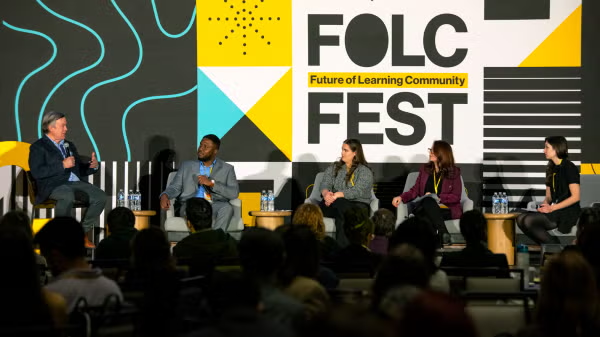
FOLC Fest 2025 explores Principled Innovation, leadership and learning at ASU
"Principled Innovation is about using our creativity, knowledge and resources to make decisions that ultimately benefit humanity — not just in the short term, but for generations to come."That's what…

These Sun Devils are inspiring the next generation of female athletes
This year, Women's History Month is celebrating the theme “Moving Forward Together! Women Educating and Inspiring Generations.”Women in sports inspire fans of all ages through their accomplishments…



